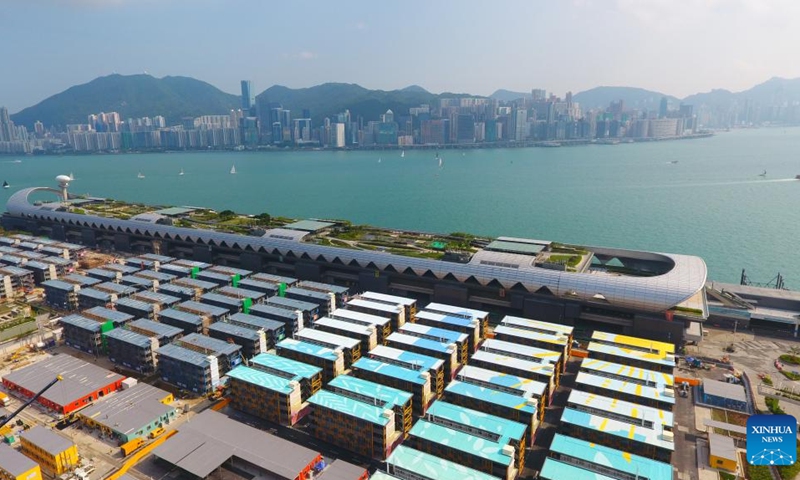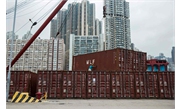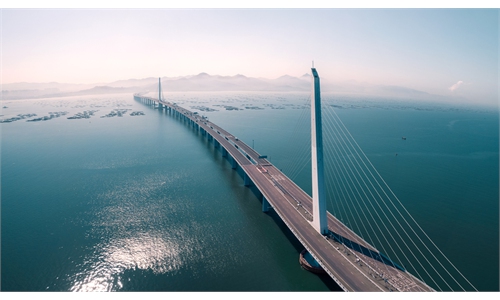Over past 25 years, HK’s status as global trade and shipping hub is being consolidated
Chinese mainland provides strong support for 25 years

Aerial photo taken on May 20, 2022 shows a view of the Kai Tak Cruise Terminal in South China's Hong Kong. This year marks the 25th anniversary of Hong Kong's return to the motherland. (Photo: Xinhua)
During the past 25 years, Hong Kong's status as a global trade and shipping center has been through both ups and downs, but the city has repeatedly reemerged with the strong support from the Chinese mainland.
In the process of becoming an international trade center, Hong Kong substantially benefited from its unique role as the unique gateway between the huge mainland market and the rest of the world, especially after China's accession to the WTO when the country's foreign trade boomed, according to businesses and experts.
In the 1990s, foreign buyers and investors came to the Chinese mainland via Hong Kong, and the city's exhibitions attracted enterprises from every corner of the world, greatly driving the development of tourism, hospitality and retail in the metropolis, Ken Wong, director of Hong Kong-based All Times Healthy Co, who has been engaged in the trade sector for 43 years, told the Global Times.
In a sign of the central government's support to Hong Kong's status as a trading and shipping hub, the Chinese mainland and Hong Kong signed the Mainland and Hong Kong Closer Economic Partnership Arrangement (CEPA) agreement on June 29, 2003.
Since the signing of the agreement, its content has been continuously developed and updated. In 2020, the mainland further opened up its services sectors including legal services, construction and related engineering services, while also lowering the threshold for the entry of Hong Kong enterprises and talent.
Thanks to the rapid integration of the Guangdong-Hong Kong-Macao Greater Bay Area, Shenzhen, South China's Guangdong Province - one of the most important ports connecting Hong Kong - saw a rapid increase in trade with Hong Kong. Customs data showed that trade value between the two cities surged more than 10 times since 1997 to reach 722.54 billion yuan ($107.81 billion) in 2021, the Shenzhen Daily reported.
"Compared with other mainland pilot free trade zones such as Shenzhen and Shanghai, Hong Kong as a free trade port has unparallel advantages such as its extensive networks with the rest of the world, sound legal system and comprehensive financial services," Liu Guohong, director of the Department of Finance and Modern Industries under the Shenzhen-based China Development Institute, told the Global Times.
Despite the social unrest in 2019 and the COVID-19 pandemic, Hong Kong's status as international trade hub has not been weakened, buoyed by its excellent connectivity with the Chinese mainland. According to the WTO, Hong Kong became the world sixth-largest exporter of merchandise trade in 2020, up two places over the previous year. In terms of container throughput, Hong Kong ranked 9th place globally.
Back in 2004, Hong Kong was the world's top container port and had held that title for several years prior. However, as the economic structure of Hong Kong evolves and Chinese mainland-based cities rapidly grew following WTO entry, Hong Kong ceded that title to Singapore in 2005 and then was surpassed by Shanghai in 2007. In 2021, Hong Kong's container throughput was 17.79 million TEUs (twenty-foot equivalent unit), compared with 47 million TEUs handled by Shanghai, the world's largest port.
"On my first trip, I felt like a student," Steven Wong, a Beijing-based shipping agent who has been frequenting Hong Kong since 2008, reflected upon his first business trip to Hong Kong in 2008.
"Gradually, I felt like a peer. Eventually, when the relative strengths between the mainland and Hong Kong are completely reversed, a host," Wong told the Global Times on Monday, noting that Hong Kong's status as a global shipping center has been facing direct challenge from Singapore after the global financial crisis of 2008.
Gary Lau, chairman of the Hong Kong Association of Freight Forwarding and Logistics, told the Global Times on Monday that the incidents of instability in recent years have left many global investors doubting on Hong Kong's future. "However, it should be made clear that many businesses still hold firm confidence in Hong Kong's prosperity amid this background as many companies still believe in the close bond of the city and the mainland, its potential and advantages," Lau said.
"Although Hong Kong has ceded the title of the world's top container port, and has no chance to retake that title in the foreseeable future, the city is banking on its quality service and expertise in special and dangerous cargo, e-commerce goods and cold-chain logistics to compensate for the loss in the volume of goods," Lau said, noting that air freight logistics have become a highlight in recent years.
Leveraging the development of the Chinese mainland, Hong Kong was able to develop marine services by making full use of its inherent advantages.
From 2001 to 2021, the fleet size of Chinese-owned vessels grew from 27.9 million tons to 217.7 million tons, accounting for 15 percent of all merchant vessels on oceans. The scale of Chinese shipping industry presented Hong Kong with new opportunities in financial lease and ship registry.
With promotion by the SAR government, Hong Kong's transport loans and advances grew by an average of 8.6 percent each year during 2010-2020 and the total value of loans grew to HK$129 billion ($16.44 billion) as of December 2020.
Today, eight of the top 10 book-runners for leading global shipping financial lease syndicated loans had offices in Hong Kong and the city also became the world's No.4 place of ship registration, trailing Panama, Liberia, and the Marshall Islands, with 2,600 vessels totaling 130 million tons registered.
China Merchants Port Holdings, the first red chip company listed on the Hong Kong stock exchange for 30 years, has been a first-hand witness to Hong Kong's remarkable journey of returning to the motherland as well as the growing presence of Chinese mainland companies operating in the city.
In an email statement sent to the Global Times on Monday, China Merchants Port said its stakes in many leading ports in the mainland and the businesses connection will continue to contribute to Hong Kong's status as global shipping center, noting that nowadays, Hong Kong should actively seize opportunities stemming from the development of the Greater Bay Area, intensify cooperation with nearby ports and focus on developing high-end services to consolidate its standing as a global shipping center.
Having raised several rounds of funding from the Hong Kong stock market, China Merchants Port has become the biggest container port operator and investor in the mainland by basing itself in Hong Kong, then using the city as a launch pad for overseas expansion from 2008 onwards, according to the statement. Today, the company has stakes in 42 ports across 25 countries.
Lau said although the importance of Hong Kong as a transit port has been weakened, it does not mean that Hong Kong's role in sea and air transport will sink into oblivion. A far-reaching trade network, rich international contacts and global trade knowledge accumulated over years of hard work, consolidated regulations and efficient customs operations all speak to Hong Kong's strength in facing future competitions, Lau said.
Under the development of the Greater Bay Area and with the sharing and flexible deployment of cargoes and facilities of the two special administrative regions and nine Guangdong-based cities, it is believed that the Greater Bay Area will wield greater advantages and Hong Kong will have a bigger role to play as a global trade and shipping hub, Lau said.
Looking ahead, experts point out Hong Kong's fortunes lie in further intensifying its connection with the mainland, serving as a link between the mainland and the overseas market under China's new 'dual circulation' development paradigm. Actively engaging in the RCEP mega free trade deal could be a main direction for the city to explore.




